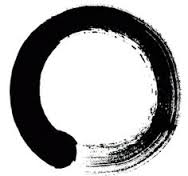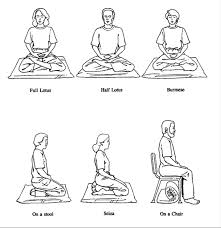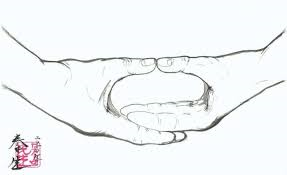Position
We tend to see body, breath, and mind separately, but in meditation they become one. The first thing is to pay attention to the body position during sitting. How you position your body has a lot to do with what happens with your mind and your breath. Throughout the years of evolution of Buddhism, the most effective position of the body for sitting meditation has been the posture of the seated Buddha. Sitting on the floor or a mat is recommended, because it is very stable. We use a cushion to raise the rear just a little, so that the knees can touch the ground. With your bottom on the pillow and two knees touching the ground, you form a tripod base that gives firmness and stability.
Legs
There are several different leg positions that are possible while seated this way.
1. Novice Position, Burmese position, in which the legs are crossed and both feet rest flat on the floor.
2. Quarter lotus, in which one foot is placed upon the opposite calf, with the other foot under the opposite thigh.
3. Half lotus, where the left foot is placed up onto the right thigh and the right leg is tucked under. This position is slightly asymmetrical and sometimes the upper body needs to compensate in order to keep itself absolutely straight.
4. Lotus, where each foot is placed up on the opposite thigh. This is perfectly symmetrical and very solid.
5.Kneel, by stacking several cushions on top of one another, straddling them as if riding a horse. This is often comfortable for beginners, but is not a stable position if you have a tendency to fall asleep during the sitting period.
6. Another kneeling position is to kneel, put a cushion on your calves, and sit on it.
7. You can also use a meditation bench consisting of a slanted board on 2 legs. Put it over the calves as you kneel on the mat and then sit on the bench.
8. Kneeling used by Japanese Samurai or in Martial arts so on can move from meditative posture to one feet quickly.
8. Sitting on a chair:
9. Standing: in this case the proper form is to put your hands in hapchang
Stability and efficiency are the important reasons sitting cross-legged works so well. There is absolutely no esoteric significance to the different positions. What is most important in sitting meditation is what you do with your mind, not what you do with your feet or legs.
Straight Spine, Face, Mouth and Nose
Once you’ve positioned yourself, there are a few other things you can check on. The mouth is kept closed. If possible, breathe through your nose. The tongue is pressed lightly against the upper palate. This reduces the need to salivate and swallow. The eyes are kept lowered, with your gaze resting on the ground about 70 to 100 cm in front of you. Your eyes will be mostly covered by your eyelids, which eliminates the necessity to blink repeatedly. The chin is slightly tucked in, so that your head is tilted down at a 45 degree angle. Although the position during sitting meditation looks very disciplined, the muscles should be soft. There should be no tension in the body. It doesn’t take strength to keep the body straight. The nose is centered in line with the navel, the upper torso leaning neither forward nor back.
Hands
The hands are folded in the cosmic mudra. The dominant hand is held palm up holding the other hand, also palm up, so that the knuckles of both hands overlap. Your right hand is holding the left hand. The thumbs are lightly touching, thus the hands form an oval, which can rest on the upturned soles of your feet if you’re sitting full lotus. If you’re sitting Burmese, the mudra can rest on your thighs. The cosmic mudra is exactly in the place of your energetic center – hara or tantien – thus tends to turn your attention inward.
Breathing
One of the most simple and basic techniques of meditation is to focus on the breath. It is always with us – anytime, anywhere. The word “spirit” means breath. The words “ki” in Japanese and “chi” in Chinese, meaning power or energy, both derive from breath. Breath is the vital force; it’s the central activity of our bodies. Mind and breath are one reality: when your mind is agitated your breath is agitated; when you’re nervous, you breathe quickly and shallowly; when your mind is at rest, the breath is deep, easy, and effortless.
Center
It is important to center your attention in the tantien (danjeon (Kor.) hara (Jap.) Your tantien is located two inches below the navel. It’s the physical and spiritual center of the body. Put your attention there; put your mind there. As you practice sitting meditation more, you’ll become more aware of the tantien as the center of your awareness. Conceive of this point as the beginning and end of all phenomena that arise in the mind. In Zen we say, “This is your don’t know center’, as your mind is truly before thinking if you focus on your tantien.
Mind
We can use several techniques to keep a mind which is clear like space, clear like a mirror:
This form of meditation involves just sitting and being aware of the sound(s) or silence in this moment. You hear the birds on the trees, the cars going by, the planes overhead, and the children playing outside. While perceiving the sounds, turn your attention inwards and experience what it is that perceives the sound. You will notice that your thinking interrupts this perception and takes you away from the moment into a mind which has past, present or future. If this happens, return to this moment by perceiving the sounds again. If you have too much thinking, you may find the next technique more useful.
If your thinking is still too rampant, you may recite a mantra, paying attention to it and letting all thoughts disappear. This takes some practice since it is very easy to let one part of the brain ‘chant’ the mantra while the other part is thinking about dinner or going to the movies. When this happens, gently bring the mind back to the mantra without any judgment. The shorter the mantra, the easier it is to grasp it and use it, though in the long run any length of mantra is good. Keep the mantra without being attached to it, and perceive where it comes from. Then the result should be the same as with the other two techniques.
If your mind wanders off, simply return to the moment, return to your practice you have chosen. Even if you want to change your technique, give yourself enough time to explore what you have initially chosen.
Do not suppress anything which arises in the mind, also do not follow it. Let it appear before your mind-mirror, and if there has to be a solution to the issue or an answer to a question, it will appear by itself. Do not try to force this with your thinking.
If you persist with not moving body, not moving speech and not moving mind, your karma will gradually grow less and less. Do not attach to any experience. Use your growing wisdom and compassion to help this world.


